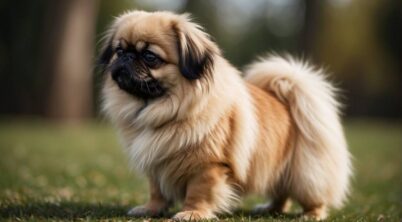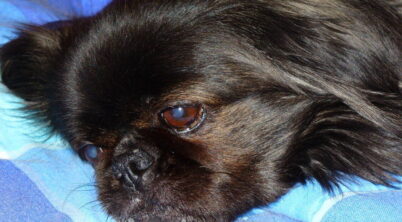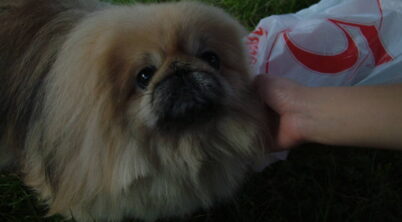The Pekingese, a revered member of the toy breed group, is a canine embodiment of history and regality. Originating from China, this ancient breed was once the cherished companion of the Chinese imperial family, earning the moniker “lion dog” for its distinctive mane and lion-like appearance. Known for their loyal and affectionate nature, Pekingese dogs carry themselves with a dignified poise that mirrors their aristocratic past. Despite their small stature, they possess a bold and intelligent demeanor, characteristics that made them favored pets among Chinese royalty.
However, their distinctive physical traits, such as the brachycephalic face, require thoughtful and tailored enrichment to maintain their well-being. The brachycephalic condition of the Pekingese breed impacts their breathing and ability to tolerate strenuous exercise. Consequently, their enrichment activities should be engaging yet moderate, to accommodate their physical limitations and avoid any health complications.
Providing enrichment for a Pekingese involves accommodating their need for mental stimulation, companionship, and moderate physical activity. The breed’s intelligence demands engaging exercises that can stimulate their minds, while their social nature makes them seek out companionship, whether it’s with their human caretakers or other dogs. Enrichment activities should be shaped by the recognition of their past, reflecting the breed’s evolution from the laps of emperors to modern-day family members.
Table of Contents
Pekingese Enrichment
The Pekingese, a toy breed with an enchanting lion-like appearance, holds a regal history that dates back to ancient China. Once cherished by the Chinese Imperial family in Beijing, these dogs require proper enrichment that caters to both their noble heritage and their unique personality traits.
Physical Activity: They need regular, moderate exercise. Short walks and play sessions can keep them physically engaged without overexertion.
- Indoor play: Soft toys, mild tug-of-war
- Outdoor walks: Leashed strolls in secure, serene environments
Mental Stimulation: Despite their small size, Pekingese possess a sharp intellect that thrives when challenged.
- Puzzle feeders: Encourage problem-solving
- New commands: Stimulate mental agility
Social Interaction: Pekingese form intense bonds with their owners. Consistent companionship is crucial.
- Regular interaction: Quality time with their human family
- Controlled socializing: Meet-and-greets with known, friendly pets
Comfort and Rest: As descendants of royalty, they have an innate desire for a serene and comfortable resting space.
- Quiet corner: A dedicated, cozy bed away from noise
- Privacy: Respect their need for occasional alone time
Autonomy: Offering a Pekingese choice in its activities empowers them and enhances contentment.
- Self-play: Access to toys they can engage with independently
- Exploration: Safe spaces where they can wander and explore at will
Providing for a Pekingese’s enrichment should honor both their physical abilities and their dignified lineage. A well-enriched Pekingese is more likely to be a content and delightful companion.
Behavior and Temperament
Understanding the behavior and temperament of Pekingese is vital for providing proper enrichment. This section explores the distinct personality traits of Pekingese and their socialization needs to ensure they develop into well-adjusted pets.
Personality Traits
The Pekingese is known for confidence and a somewhat independent streak, often displaying a regal and affectionate attitude towards their family. They possess a strong sense of loyalty, finding comfort in the presence of their owners. However, this breed can show territorial behaviors, leading to excessive barking if they aren’t trained properly. Their independence can sometimes be mistaken for aloofness, and while they form deep bonds with their families, they may not always seek out social interactions.
Pekingese are affectionate and enjoy being lap dogs, which showcases their need for attention and interaction with their human companions. Despite their small size, they can have a bold and sometimes stubborn temperament, which can manifest as behavior problems if not addressed through consistent training.
Socialization Needs
Early socialization plays a crucial role in shaping a Pekingese’s temperament. Exposing them to various people, environments, and situations helps in reducing potential aggression and territorial issues. It is essential that a Pekingese learns to navigate social settings from a young age to mitigate possible defensive reactions, such as barking at strangers or acting out towards other dogs. Pekingese owners should prioritize consistent and gentle socialization practices to ensure their pets mature into sociable and well-mannered dogs.
Without proper socialization, a Pekingese may retain an independent nature, which can sometimes escalate to problematic behavior. It is important for the Pekingese to learn to be comfortable around both humans and other animals to avoid developing a too-exclusive attachment to their primary caretaker, which can lead to separation anxiety and other issues.
Health and Wellbeing
The health and wellbeing of a Pekingese are deeply interconnected with their routine care, and balanced exercise and diet. Attending to these aspects is key to managing common health conditions and ensuring a healthy life span for these brachycephalic dogs.
Routine Care
Dental Health:
- Regular dental check-ups and daily brushing
- Professional cleanings to prevent dental diseases
Skin Care:
- Routine grooming to avoid skin issues like dermatitis and hot spots
- Monitoring for signs of allergies regularly
Breed-Specific Health Considerations:
- Health checks to monitor for conditions typical in Pekingese, such as respiratory issues due to their brachycephalic nature
Exercise and Diet
Exercise Needs:
- Short but frequent walks to accommodate the Pekingese’s energy levels
- Avoid excessive exercise to prevent respiratory distress
Dietary Management:
- Balanced diet to maintain ideal weight and prevent obesity
- Smaller meals that are appropriate for the Pekingese’s size
Health Risks From Obesity:
- Increased risk of joint damage, heart disease, and other obesity-related health conditions
Breeding Considerations:
- Responsible breeding practices to minimize inherited health issues
- Awareness of the breed’s susceptibility to certain conditions due to their compact structure
Training and Enrichment
Effective training and enrichment for a Pekingese require an understanding of their specific needs and behaviors. These dogs thrive on careful attention and positive reinforcement, making the right approach crucial for their mental and physical well-being.
Basic Training Principles
A Pekingese is an intelligent companion dog that responds well to consistent and patient training methods. Positive reinforcement is key, as they are known to be more receptive when motivated by treats or praise. It’s essential to start obedience training early, focusing on basic commands to foster good behavior. Short, engaging sessions are preferred to maintain the Pekingese’s attention. Clear communication and regular interaction help in establishing a strong bond between the dog and its owner, which is the foundation for successful training.
Enrichment Activities
To keep a Pekingese mentally stimulated and physically active, enrichment activities should be incorporated into their daily routine. Exercise can be moderate, due to their small size, but they must engage in physical activity to prevent behavioral problems. Examples of enrichment activities include:
- Interactive toys to challenge their mind
- Short walks or play sessions for exercise
- Training for simple tricks to promote cognitive health Encouraging exploration and sensory experiences can also enhance a Pekingese’s quality of life.
Overcoming Challenges
Pekingese may present training and behavioral challenges due to their independent nature. Consistency in training and setting boundaries is imperative to overcome housebreaking issues or stubbornness. When tackling behavioral problems, a calm and assertive approach is recommended. For traveling or adapting to new environments, gradual acclimatization and continued positive experiences are helpful. In all cases, patience and persistence are important to help a Pekingese adjust and thrive.
Living with a Pekingese
Living with a Pekingese requires an understanding of their unique personality traits and needs to foster a harmonious environment.
Daily Routines
Establishing a consistent daily routine is crucial for a Pekingese’s well-being. Schedules should include:
- Meals: Serve two meals a day with a balanced diet to maintain their health.
- Exercise: Despite their small size, Pekingeses thrive on daily walks with their rolling gait on display.
- Training: Regular, short training sessions can help manage assertive behavior and prevent potential destructive behavior due to boredom.
- Affection: Schedule regular, quiet time for affection, reinforcing their bond with human companions.
Adaptation to Family Life
The ability of a Pekingese to adapt to family life varies:
- With Children: Older children who understand how to handle them with respect are ideal. Pekingeses may not tolerate the abrupt actions of toddlers.
- Other Pets: They can get along with other pets if introduced properly, but it’s best to monitor interactions early on.
- Behavioral Adaptation: Pekingeses may be prone to excessive barking and assertiveness. Address such behavior problems early with consistent, gentle training.
- Environment: They appreciate a comfortable living area where they can retreat for peace and comfort.
Owners must recognize that a Pekingese isn’t just a pet but a steadfast companion that requires love, structure, and mutual respect.
* Banner photo by Tim Ellis, cropped | Some rights reserved








